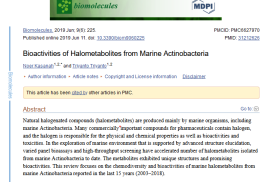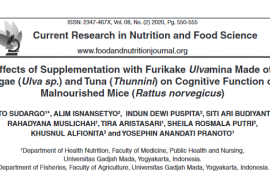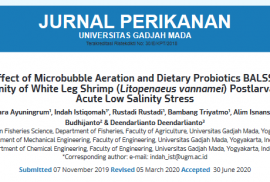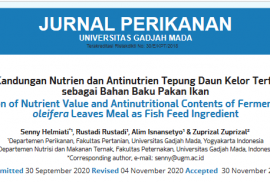| Judul/Title | Antivibriosis and cytotoxicity of Actinobacteria associated with red seaweed Gelidiella acerosa |
| Penulis/Author | Maria Ulfah, Noer Kasanah, Nastiti Wijayanti |
| Tanggal/Date | 2021 |
| Abstrak/Abstract | Vibriosis causes a problem in aquaculture and human health. The antibiotic resistance and the limited availability of antimicrobial agents are the driving force for searching for new antivibrio compounds from natural products. Herein, we evaluated ten marine Actinobacteria isolated from red seaweed Gelidiella acerosa for antivibriosis, cytotoxicity and secondary metabolites genes in the way to find a new antivibrio agent. Five Actinobacteria isolates exhibited activity against Vibrio alginolyticus and Vibrio parahaemolyticus with MIC ranging from 0.625 to 5 µg/µl. All isolates displayed no cytotoxicity against Vero cell line except for isolate DR-2R-115–8. All isolates harbour nrps gene, which might indicate that these isolates have great potential in the production of bioactive peptides while none of the isolates showed the presence of pks I, II and hmgcr genes. Identification of ten isolates of marine Actinobacteria associated with red algae was classified into four genera of Brevibacterium, Nocardiopsis, Allokutzneria and Brachybacterium. Our study revealed that the marine Actinobacteria associated with red algae Gelidiella acerosa were promising sources for controlling vibriosis. |
Arsip:
Journal
| Judul/Title |
Bioactivities of Halometabolites from Marine Actinobacteria
|
| Penulis/Author | Noer Kasanah, Triyanto |
| Tanggal/Date | 2019 |
| Abstrak/Abstract | Natural halogenated compounds (halometabolites) are produced mainly by marine organisms, including marine Actinobacteria. Many commercially important compounds for pharmaceuticals contain halogen, and the halogen is responsible for the physical and chemical properties as well as bioactivities and toxicities. In the exploration of marine environment that is supported by advanced structure elucidation, varied panel bioassays and high-throughput screening have accelerated number of halometabolites isolated from marine Actinobacteria to date. The metabolites exhibited unique structures and promising bioactivities. This review focuses on the chemodiversity and bioactivities of marine halometabolites from marine Actinobacteria reported in the last 15 years (2003–2018) |
https://doi.org/10.3390/biom9060225
| Judul/Title |
Dynamic change in bacterial communities in the integrated rice–fish farming system in Sleman, Yogyakarta, Indonesia
|
| Penulis/Author | Afri Herlambang, Murwantoko Murwantoko, Indah Istiqomah |
| Tanggal/Date | 2021 |
| Abstrak/Abstract | An integrated rice–fish farming system is an efficient technique used to maintain water quality and rice/fish productivity. In addition to fish and rice plants that have mutually beneficial ecological roles, bacteria play important roles in maintaining water quality and soil fertility. Therefore, this study investigated the diversity and dynamic change in the bacterial community composition of water and sediment in an integrated rice–fish farming system using a high-throughput sequencing approach. The 16S rRNA gene of bacteria was amplified, and the IonS5™XL sequencing platform was used to identify bacterial community during the cultivation period. The results demonstrated that fishpond, rice field and trench sediment samples were dominated by the phyla Proteobacteria (60.9%–64.4%), Acidobacteria (8.7%) and Chloroflexi (6.3%), whereas water samples were dominated by the phyla Proteobacteria (65.7%), Bacteroidetes (17.1%) and Actinobacteria (8.5%). The dynamics of the bacterial community composition of the water and sediment samples were clearly observed at phylum and genus levels respectively. Water temperature (34.67°C) and ammonia-nitrogen content (0.38 mg L−1) at the early stage of cultivation correlated with the abundances of Actinobacteia and Cyanobacteria at the phylum level and Acinetobacter at the genus level. Furthermore, several bacterial genera could potentially contribute to the biogeochemical cycle. In particular, Sorangium was involved in organic matter degradation, Methylophilus was implicated in nitrification, Novosphingobium and Methylotenera were essential for denitrification, and Desulfobacca was important for sulfate reduction. This study improved our understanding of the bacterial community in the integrated rice–fish farming system and provided data for further development. |
https://doi.org/10.1111/are.15432
| Judul/Title | Chemical composition diversity of fucoidans isolated from three tropical brown seaweeds (Phaeophyceae) species |
| Penulis/Author | FADILAH NORLAILI LUTFIA (1); Dr. Ir. Alim Isnansetyo, M.Sc. (2) ; Prof. Dr. Ratna Asmah Susidarti, MS., Apt. (3); Muhammad Nursid (4) |
| Tanggal/Date | 4 2020 |
| Abstrak/Abstract | Abstract. Lutfia FN, Isnansetyo A, Susudarti RA, Nursid M. 2020. Chemical composition diversity of fucoidans isolated from three tropical brown seaweeds (Phaeophyceae) species. Biodiversitas 21: 3170-3177. Fucoidan is a polysaccharide with high sulfate content, found in the cell walls matrix of brown seaweed. Its bioactivities vary depending on the algae species and the chemical structure. The aims of this research were to extract, purify, and characterize fucoidan from three Indonesian brown seaweed, Sargassum sp., Turbinaria sp., and Padina sp. The extraction was carried out using acid method followed by precipitation with ethanol and CaCl2, while its purification using DEAE-cellulose ion-exchange chromatography. Characterization was performed by FTIR and 1H-NMR spectroscopic analyses. Chemical components of fucoidan determined were total carbohydrates, sulfate residue, uronic acid residue, and monosaccharide components. The results revealed that the Turbinaria sp. produced highest yield of fucoidan (4.8% dry matter), followed by Sargassum sp. (2.7% dry matter) and Padina sp. (2.6% dry matter). The carbohydrate contents of Sargassum sp., Turbinaria sp. and Padina sp. fucoidan were 64.55±0.12%, 67.42 ± 0.03% and 62.90 ± 0.04% with sulfate residues of 0.013% ± 4.71; 19.47±0.002% and 0.016%±8.81; and uronic acid residues of 25.19±0.03%; 12.69±0.03% and 12.91±0.01%, respectively. Sargassum sp., Turbinaria sp., and Padina sp. fucoidans consist of fucose and some other minor monosaccharides. |
| Judul/Title | Effects of Supplementation with Furikake Ulvamina Made of Algae (Ulva sp.) and Tuna (Thunnini) on Cognitive Function of Malnourished Mice (Rattus norvegicus) |
| Penulis/Author | Dr. Toto Sudargo, SKM., M.Kes. (1) ; Dr. Ir. Alim Isnansetyo, M.Sc. (2); Indun Dewi Puspita, S.P., M.Sc. Ph.D. (3); Dr. R.A. Siti Ari Budhiyanti, S.T.P., M.P. (4); Rahadyana Muslichah, S.Gz., M.Sc. (5); TIRA ARISTASARI (6); SHEILA ROSMALA PUTRI (7); KHUSNUL ALFIONITA (8); Yosephin Anandati Pranoto, S.Gz., M.S., R.D. (9) |
| Tanggal/Date | 10 2020 |
| Abstrak/Abstract | Algae (Ulva sp.) and tuna (Thunnini) are edible marine resources rich in protein, essential amino acids, zinc, and iodine that can be used to improve the growth of malnourished children including their cognitive functions. The combination of both resources may produce a supplementation (Furikake Ulvamina) with nutritional quality to support the acceleration of cognitive functions of malnourished children. This study aimed to develop a marine-based product/supplement to accelerate cognitive functions in malnourished mice (Rattus norvegicus). A product called “Furikake Ulvamina” was used in an experimental study of 25 malnourished mice. The Morris Water Maze test was adapted into a “speed time to survive” to test the cognitive functions of each group. One-way Anova tests were performed to statistically analyze the mean differences in the speed of time to survive before and after the intervention. All five groups showed an increase in the speed of time to survive after treatment was given with an average increase of speed of 26.9 seconds. Statistically, there was no significant difference in this cognitive function acceleration indicator between groups (p>0.05). Furthermore, weight and length were also increased after four weeks in all groups. There was no significant difference in cognitive function acceleration in each group of mice after the supplementation of Furikake Ulvamina for four weeks. This product may potentially accelerate growth in malnourished mice. Furikake Ulvamina can also promote the consumption and benefits of Indonesian marine local commodities (algae and tuna). |
| Judul/Title | Morphometric variation of Cork fish (Channa striata Bloch, 1793) from nine populations in Sumatra Island, Indonesia |
| Penulis/Author | BOBY MUSLIMIN (1); Prof. Dr. Ir. Rustadi, M.Sc. (2); Dr. Ir. Ignatius Hardaningsih, M.Si. (3); Dr. Bambang Retnoaji, M.Sc. (4) |
| Tanggal/Date | 7 2020 |
| Abstrak/Abstract | The geographic isolation and specific character of local habitat could cause variation of morphological characteristics among Cork fish population in different locations. The plasticity of cork fish to adapt to the environment factors possibly has an impact on the different of specific morphological on fish population at different habitat. This study was conducted to investigate the traditional morphometric measurement and truss network differentiation of cork fish populations in different locations at Sumatra Island. Total of 394 cork fish specimens (consisting of 198 males and 196 females) were collected from nine different areas of rivers, swamp and lakes. The samples were analysed based on 14 morphometric (M) and 21 Truss Network Measurement (TNM) characters to find out the significant correlation of the fish on each area sampling. The transformed datasets were proceeded to multivariate testing using Discriminant Function Analysis (DFA) and Cluster Analysis (CA). The results showed that cork fish had 20 distinguishing predominant characters in the head and back of the body. Based on cluster analysis, those fishes were divided into 4 groups depending on geographical isolation except one floodplain population that differs from the other population groups. We revealed that phenotypic dimorphism for female cork fish had a dominant size compared to males in head region and tail fin region. Cork fish in the lake had a dominant body height size compared to rivers and flooded swamps. |
| Judul/Title | Viability of Najawa carp (Cyprinus carpio L.) sperm at 4°C temperature storage |
| Penulis/Author | Dimas Fendy Pradana (1); Dr. Ir. Ignatius Hardaningsih, M.Si. (2); Dr. Dini Wahyu Kartika Sari, S.Pi., M.Si. (3) |
| Tanggal/Date | 10 2020 |
| Abstrak/Abstract | The objectives of this study were to evaluate the sperm viability of Najawa carp (Cyprinus carpio L.) in cryopreservation pre-conditions at 4°C. The design used in this study was Complete Randomized Design with 4 treatments, BSS as a control, 10% DMSO, 0,2 M Sucrose, and 5% DMSO + 0,1 M Sucrose; each consist of three replications. The parameters observed were progressive motility of fresh sperm, diluted sperm before low temperature storage, and 2 hours; 3 hours; 4 hours; 5 hours; one day; one week; a month after 4°C storage. The data were analyzed by ANOVA. The data showed that there was no significant difference between treatment (P>0.05). The best viability was 40.56% of sperm motility which survive for one week, it was achieved by 5% DMSO + 0,1 M Sucrose. |
| Judul/Title | Replacement of fish meal with fermented Moringa leaves meal and its effect on the growth performance of red tilapia (Oreochromis sp.) |
| Penulis/Author | Dr. Senny Helmiati, S.Pi., M.Sc. (1); Prof. Dr. Ir. Rustadi, M.Sc. (2); Dr. Ir. Alim Isnansetyo, M.Sc. (3) ; Prof. Dr. Ir. Zuprizal, DEA. (4) |
| Tanggal/Date | 26 2020 |
| Abstrak/Abstract | The purpose of the present research was to evaluate the nutritional content of fermented Moringa oleifera leaves meal and to find out the effect of fish meal replacement with fermented Moringa leaves meal (FMLM) in diets on the growth performance of red tilapia (Oreochromis sp.). The treatments include replacement of the fish meal with FMLM at 0, 10, 20, and 30%. Red tilapia with total length of 9-10 cm was fed twice daily for two months at a feeding rate of 3% of total biomass. The results revealed that fermentation increased the moisture, protein, ash, total lipid, calcium, and phosphorous content in Moringa leaves meal (MLM). The fermentation process actually reduced the anti-nutrient substances (phenol, tannin, phytic acid, and hydrogen cyanide (HCN)) in MLM. Fish meal replacement with FMLM in diets significantly affected feed digestibility. FMLM can be used as a replacement for fish meal in diet at 30% with only limited effect on the growth performance of red tilapia |
| Judul/Title | Protective Effect of Microbubble Aeration and Dietary Probiotics BALSS on Survival and Immunity of White Leg Shrimp (Litopenaeus vannamei) Postlarvae against Acute Low Salinity Stress |
| Penulis/Author | Indah Istiqomah, S.Pi., M.Si., Ph.D (2) ; Prof. Dr. Ir. Rustadi, M.Sc. (3); Dr. Ir. Bambang Triyatmo, M.P. (4); Dr. Ir. Alim Isnansetyo, M.Sc. (5); Wiratni, S.T., M.T., Ph.D. (6); Dr. Deendarlianto, S.T., M.Eng. (7) |
| Tanggal/Date | 30 2020 |
| Abstrak/Abstract | Survival rate and immunity of white leg shrimp (Litopenaeus vannamei) postlarvae against acute salinity stress were evaluated in indoor experimental trials. The research was conducted with 2×2 factorial design with two levels of aeration (microbubble and macro bubble) and two levels of diet (with and without probiotics) resulting four treatments in triplicate: application of microbubble with gut probiotics (MiP), without gut probiotics (MiC), and macro bubble with gut probiotics (MaP) and without probiotics (MaC). White leg shrimps measuring 7.6 g were maintained in the tanks for 60 days and fed five times a day at a dose of 5% biomass. Harvested shrimp were tested for low salinity stress (5 ppt) for 3 hours. Glucose level, total protein, bactericidal activity, natural agglutination, phenoloxidase, respiratory burst, and superoxide dismutase activities in the hemolymph and the shrimp survival rate (SR) were analyzed before and after the stress tests. Although all examined parameters remained the same between groups before the stress test, significant differences were found among them after the stress test. Microbubble aeration obtained stabilization of hemolymph glucose level, best survival rate, bactericidal activity, and agglutination activities. No significant effect was resulted by the dietary probiotic treatments, but the interaction with aeration treatments revealed the importance to compensate shrimp survival rate when microbubble aeration is unavailable. |
| Judul/Title | An Evaluation of Nutrient Value and Antinutritional Contents of Fermented Moringa oleifera Leaves Meal as Fish Feed Ingredient |
| Penulis/Author | Dr. Senny Helmiati, S.Pi., M.Sc. (1) ; Prof. Dr. Ir. Rustadi, M.Sc. (2); Dr. Ir. Alim Isnansetyo, M.Sc. (3); Prof. Dr. Ir. Zuprizal, DEA. (4) |
| Tanggal/Date | 30 2020 |
| Abstrak/Abstract | The aim of the study was to evaluate nutritive value and antinutritional contents of fermented Moringaoleifera leaves meal as a plant-based protein source as an alternative ingredient for aquafeed. The research stages included processing of M. oleifera leaf meal, preparation and calculation of bacterial density, fermentation process, and analysis of nutrient and antinutrient content. The bacteria used for fermentation is a mixture of T2A (Bacillus sp.), T3P1 (Bacillus sp.) and JAL11 (Lactococcus raffinolactis) bacteria with a density of 2.16×109 cfu/mL. Fermented M. oleifera leaves meal was carried out for 168 hours. Analysis of nutrient content and antinutrient substances of fermented M. oleifera leaves meal was carried out at 24, 48, 72, 96, 120, 144 and 168 hours. The nutrient content of Moringa leaf meal includes moisture (9.04±0.00%), ash (9.70±0.21%), protein (25.77±0.08%), fat (4.80± 0.52%), crude fiber (11.60±0.13%), extract material without nitrogen (39.06±0.52%), energy (351.27±3.27 kcal/100 g), hemicellulose (13.79±0.07%), cellulose (9.9±0.06%) and lignin (15.34±0.31%). Fermentation can increase moisture, ash, protein and fat content, and reduce crude fiber content, nitrogen free extract, hemicellulose, cellulose, lignin and antinutrients, including phenols, tannins, phytic acid and HCN. The results of the present study show that fermentation is able to improve nutrient dan decrease antinutritional content of M. oleifera leaves meal as a plant-based protein source for further use in aquafeed ingredient. |












